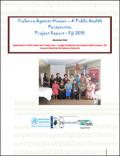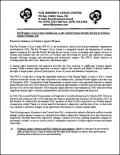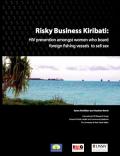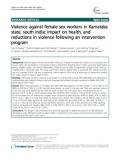What's New
Displaying results 3871 - 3880 of 4914

Resource | Publications,
In this report, WHO outlines how countries can modify their financing systems to move more quickly towards universal coverage and to sustain those achievements. The report synthesizes new research and lessons learnt from experience into a set of possible actions that countries at all stages of development can consider and adapt to their own needs. It suggests ways the international community can support efforts in low-income countries to achieve universal coverage.

Resource | Publications,
The Violence Against Women (VAW) project team was commissioned by the World Health Organization (WHO) South Pacific office in July 2010, to conduct a host of VAW activities as components of the Project in Fiji. This report is one of the main outcomes of that partnership between the College of Medicine, Nursing & Health Science (formerly known as Fiji School of Medicine) /Fiji National University, Ministry of Health Fiji and WHO.

Resource | Publications,
Violence against women stems from discriminatory social attitudes, norms and practices that perpetuate structural gender inequality. Grantees of the UN Trust Fund target prevention approaches to confront these views at the individual, family and community level.
This report highlights practices from 2010 that contribute substantially to our understanding of what works, and what doesn’t, in ending violence against women. Results focus on the UN Trust Fund’s investments in three key areas: prevention, expanding access to survivor services, and strengthening implementation of laws, policies and action plans to end violence against women.

Resource | Publications,
The Fiji Women's Crisis Centre (FWCC) is an autonomous, multi racial non-governmental organization established in 1984. The Fiji Women's Crisis Centre is committed towards the elimination of violence against women in Fiji and the Pacific through the provision of crisis counseling and support services to women and children who are survivors of violence and advocating for policy and legislative changes through lobbying, training and networking and institutional support. The FWCC firmly believes in working under the rule of law, democracy and human rights.
The following report illustrates to the Council how Fiji's situation has halted collaborative efforts towards ending violence against women on a national level under a democratic framework, how the situation has temporarily disabled democratic legislative changes, criminal provisions needing immediate changes by parliament, women’s access to justice, police’s inadequate response to violence against women and media censorship.

Resource | Publications,
China is currently facing a rapid and widespread increase in human immunodeficiency virus (HIV)/acquired immunodeficiency syndrome (AIDS). The activities of female sex workers (FSWs) have contributed to the mounting epidemic of HIV/AIDS and other sexually transmitted diseases (STDs). Therefore, this study aimed to assess the HIV/AIDS-related knowledge, attitude and risk behaviors among FSWs operating in Shanghai China.

Resource | Publications,
Clients of FSWs serve as potential bridges for HIV transmission from the high-risk FSWs to the low-risk general population, making them a key target for intervention. High HIV prevalence rates among clients in Kaiyuan is particularly alarming given their risk behavior patterns, including high rates of partner exchange, low condom use rates, and drug-using behaviors. Innovative interventions are needed to reduce the risk of HIV among clients and reduce the bridge of transmission to the general population.

Resource | Publications,
This report documents the findings of a qualitative investigation into the context of HIV vulnerability and risk for women who engage in sex work on board foreign boats. The research aims to inform HIV prevention strategies and programs for this group, and is based on fieldwork carried out between February and August 2010 in Tarawa, Kiribati.

Resource | Publications,
The aim of this study is to identify the prevalence of intimate partner violence (IPV) against Japanese women (JW) and non-Japanese women (NJW) in a perinatal setting. Additional purposes were to identify the associated factors of IPV, describe the characteristics of IPV against NJW, and assess the acceptability of the Violence Against Women Screen (VAWS) instrument as a screening tool. A cross-sectional survey was conducted from September to November 2007 in an urban hospital maternity clinic in Tokyo, Japan. Women who attended the maternity clinic received the VAWS instrument, which was translated into four languages (Japanese with Kanji and Hiragana, English, Chinese, and Tagalog) and was used to identify IPV.

Resource | Publications,
Violence against female sex workers (FSWs) can impede HIV prevention efforts and contravenes their human rights. We developed a multi-layered violence intervention targeting policy makers, secondary stakeholders (police, lawyers, media), and primary stakeholders (FSWs), as part of wider HIV prevention programming involving >60,000 FSWs in Karnataka state. This study examined if violence against FSWs is associated with reduced condom use and increased STI/HIV risk, and if addressing violence against FSWs within a large-scale HIV prevention program can reduce levels of violence against them.

Resource | Publications,
Over the past ten years, there has been a remarkable and virtually unprecedented global scaleup of a life-saving medical technology: antiretroviral therapy for people with advanced HIV infection. This therapy not only prolongs life for most patients, it keeps people healthy enough to work, to continue their lives in families and as parents, and to contribute to their communities and countries. We now know that antiretroviral therapy also lowers the amount of HIV in the bloodstream, thus making people less infectious and contributing to HIV prevention goals as well.
The successes of the past ten years are directly linked to the drastic fall in the price of these drugs. The cost of first generation antiretrovirals has decreased from over ten thousand US dollars to as low as 67 dollars per person per year. This amazing reduction has been achieved largely thanks to competition from generic manufacturers, which, for millions of people worldwide, has been the difference between life and death. Such competition has in large part been made possible by countries' utilization of the public health flexibilities in the World Trade Organization's TRIPS Agreement.
The Good Practice Guide analyses each of the public health flexibilities in the TRIPS Agreement
and provides examples where and how have they been used by national governments. The Guide
also provides some examples on the effect of adopting intellectual property protection measures,
which exceed the minimum requirements of TRIPS and which are often introduced through bilateral trade instruments.





